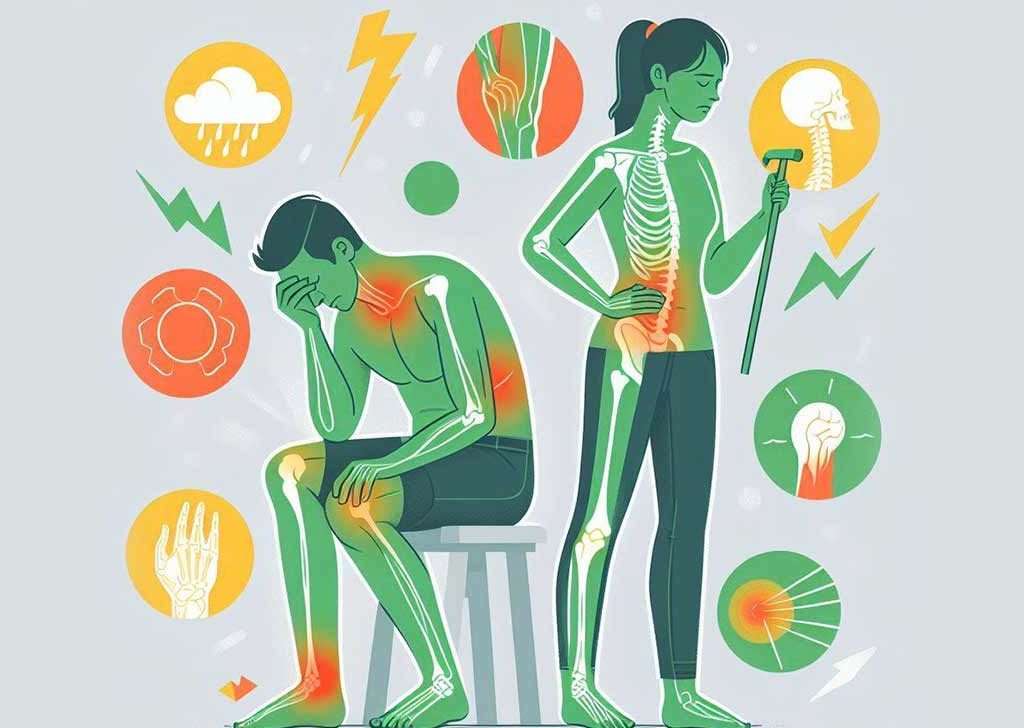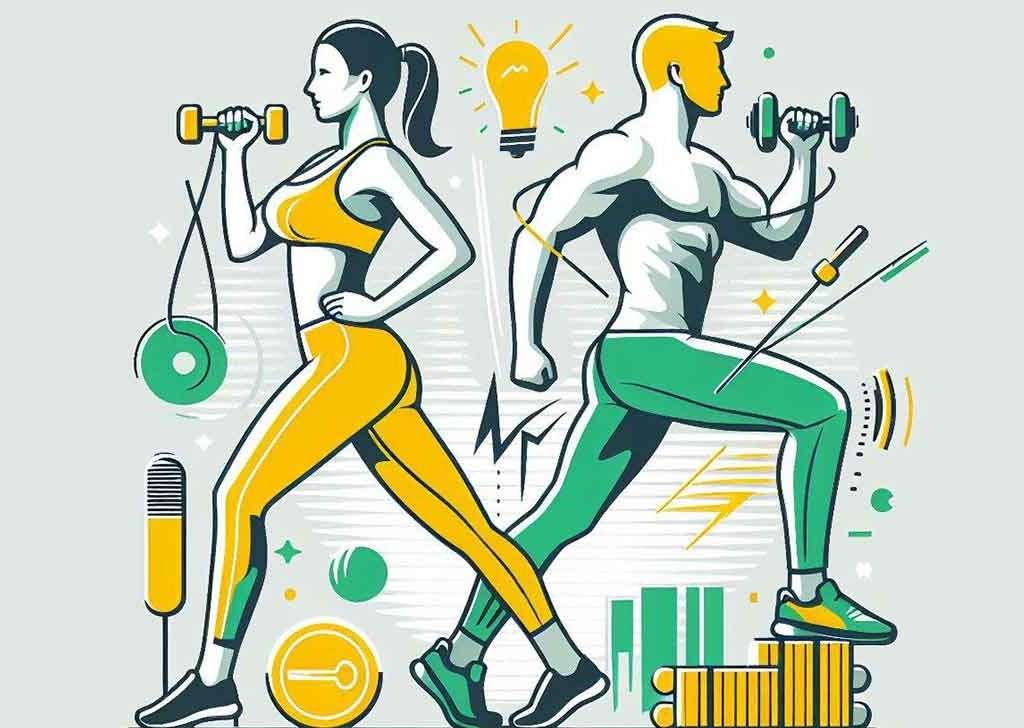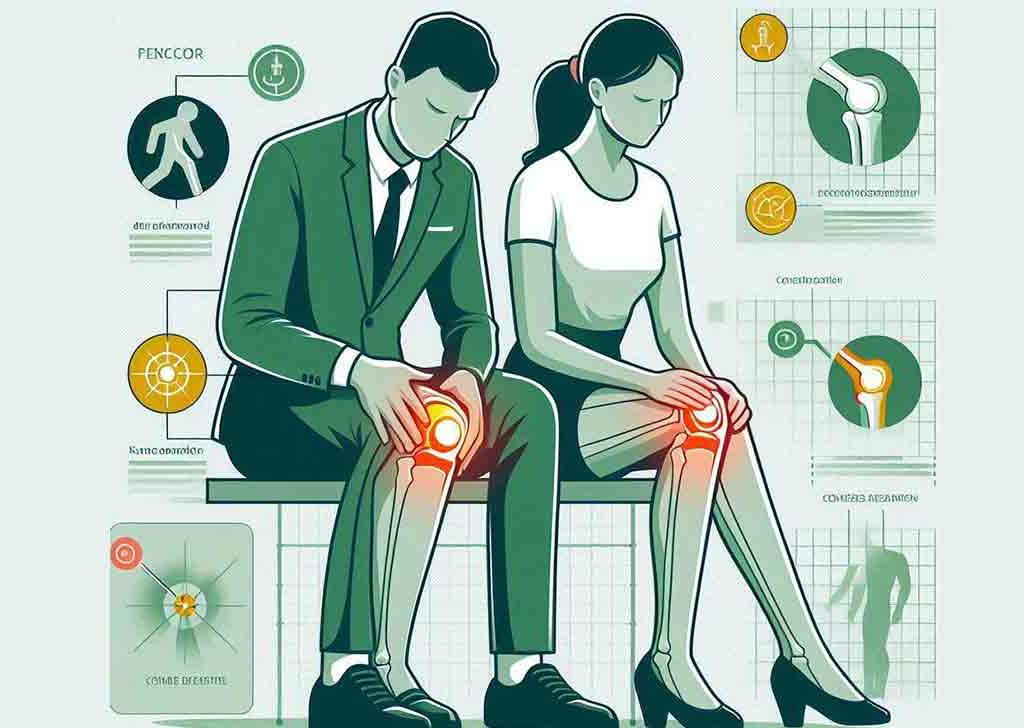Office exercises are simple physical activities that can be performed in a typical office setting without the need for specialized equipment. These exercises are designed to improve overall physical health, increase energy levels, and reduce stress. By integrating short bursts of movement into daily routines, employees can alleviate tension, enhance focus, and promote a healthier work environment.
In today’s fast-paced work environment, many professionals find themselves spending long hours sitting at desks, often leading to a sedentary lifestyle. This lifestyle can result in various health issues, including obesity, back pain, and decreased productivity. To counter these effects, office exercises have emerged as a practical solution for incorporating movement into the workday.
The importance of office exercises goes beyond physical fitness. Regular movement can also boost mental well-being by releasing endorphins, the body’s natural mood lifters. Moreover, engaging in physical activity can foster team bonding and improve workplace morale.
In this guide, we will explore various office exercises that are easy to perform, require minimal space, and can be seamlessly incorporated into your daily routine. Whether you’re looking to improve your posture, relieve stress, or simply take a break from your desk, office exercises offer an accessible and effective way to enhance your overall well-being while at work.
Table of Contents
- Introduction
- Importance of Office Exercises
- Benefits of Staying Active at Work
- Common Office Problems
- Sedentary Lifestyle Effects
- Common Ailments Associated with Office Work
- Types of Office Exercises
- Stretching Exercises
- Strengthening Exercises
- Aerobic Exercises
- Mindfulness and Relaxation Techniques
- Stretching Exercises in Detail
- Neck Stretches
- Shoulder Rolls
- Wrist and fingerstretches
- Back Stretches
- Hip Flexor Stretches
- Leg Stretches
- Strengthening Exercises in Detail
- Desk Push-Ups
- Chair Squats
- Wall Sits
- Calf Raises
- Seated Leg Raises
- Resistance Band Exercises
- Aerobic Exercises
- Benefits of Aerobic Activity
- Simple Aerobic Exercises for the Office
- Incorporating Walking Breaks
- Mindfulness and Relaxation Techniques
- Importance of Mental Health
- Deep Breathing Exercises
- Guided Imagery
- Progressive Muscle Relaxation
- Creating an Office Exercise Routine
- Setting Goals
- Incorporating Movement into Daily Activities
- Using Reminders and Technology
- Tips for Staying Active at Work
- Ergonomic Considerations
- Creating an Active Work Environment
- Encouraging Colleagues to Join
- Conclusion
- Recap of the Benefits of Office Exercises
- Final Thoughts on Staying Active at Work
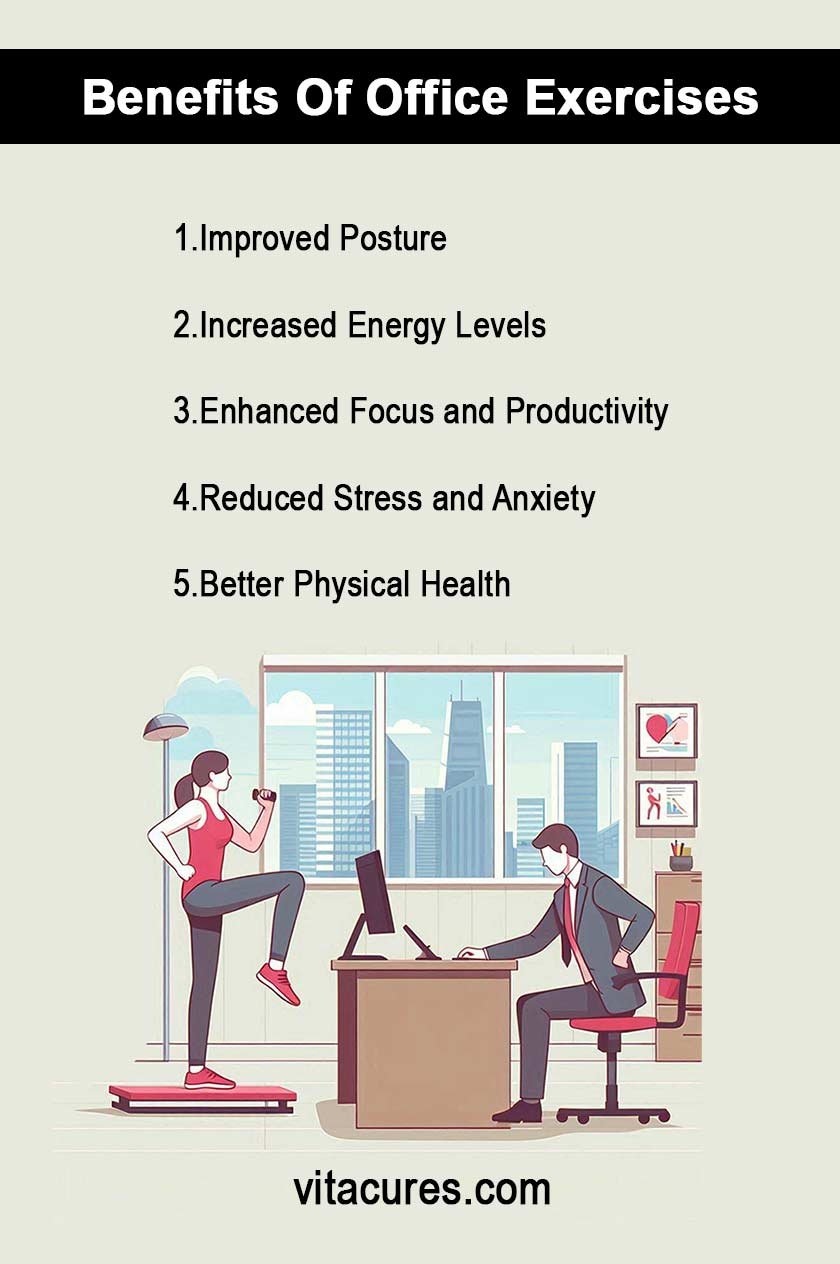
1. Introduction
Importance of Office Exercises
With the rise of technology, many people spend hours sitting at their desks, leading to a sedentary lifestyle. Office exercises are essential for counteracting the negative effects of prolonged sitting. These exercises not only improve physical health but also enhance mental well-being, boost productivity, and create a more positive work environment.
Benefits of Staying Active at Work
Engaging in regular office exercises can lead to numerous benefits, including:
- Improved Physical Health: Reduces the risk of chronic diseases like heart disease, diabetes, and obesity.
- Enhanced Mental Health: Exercise releases endorphins, which help reduce stress and anxiety.
- Increased Productivity: Physical activity can improve focus and energy levels, leading to better work performance.
- Stronger Team Bonding: Group exercises can enhance teamwork and communication among colleagues.
2. Common Office Problems
Sedentary Lifestyle Effects
A sedentary lifestyle can lead to various health problems, including:
- Obesity: Lack of physical activity can lead to weight gain and related health issues.
- Muscle Weakness: Prolonged sitting can weaken core and leg muscles.
- Poor Posture: Sitting for long periods can lead to slouched shoulders and misalignment of the spine.
Common Ailments Associated with Office Work
Common health issues associated with office work include:
- Back Pain: Often caused by poor seating posture.
- Neck Strain: Resulting from looking down at screens for extended periods.
- Carpal Tunnel Syndrome: A repetitive strain injury caused by prolonged typing.
3. Types of Office Exercises
Stretching Exercises
Stretching exercises help relieve tension, improve flexibility, and increase blood flow. They can be done at your desk or in a small space.
Strengthening Exercises
Strengthening exercises build muscle and improve overall body strength. These can be performed using body weight or simple equipment like resistance bands.
Aerobic Exercises
Aerobic exercises increase your heart rate and improve cardiovascular health. Simple aerobic activities can be incorporated into your workday.
Mindfulness and Relaxation Techniques
Mental health is as important as physical health. Mindfulness and relaxation techniques help reduce stress and improve focus.
4. Stretching Exercises in Detail
Neck Stretches
- Purpose: To relieve neck tension and improve mobility.
- How to Do It: Sit up straight. Tilt your head towards your shoulder, holding for 15-30 seconds on each side.
Shoulder Rolls
- Purpose: To reduce shoulder stiffness.
- How to Do It: Roll your shoulders forward and backward in a circular motion for 10 repetitions each.
Wrist and fingerstretches
- Purpose: To alleviate wrist and finger strain from typing.
- How to Do It: Extend one arm forward, palm up. Use your other hand to gently pull back on your fingers, holding for 15 seconds.
Back Stretches
- Purpose: To relieve lower back tension.
- How to Do It: Stand up and reach your arms overhead. Lean to one side and then the other, holding for 15 seconds on each side.
Hip Flexor Stretches
- Purpose: To counteract tightness from prolonged sitting.
- How to Do It: Stand up, take a step back with one foot, and bend your front knee. Hold for 15-30 seconds and switch sides.
Leg Stretches
- Purpose: To improve leg flexibility and circulation.
- How to Do It: Stand and hold onto a desk or wall. Lift one leg behind you, holding your ankle, and stretch for 15-30 seconds.
5. Strengthening Exercises in Detail
Desk Push-Ups
- Purpose: To strengthen the chest and arms.
- How to Do It: Place your hands on the desk, step back, and perform push-ups against the desk.
Chair Squats
- Purpose: To strengthen legs and improve balance.
- How to Do It: Stand up from your chair, lower yourself back down without sitting, and repeat for 10-15 reps.
Wall Sits
- Purpose: To strengthen leg muscles.
- How to Do It: Lean against a wall and slide down until your knees are at a 90-degree angle. Hold for 15-30 seconds.
Calf Raises
- Purpose: To strengthen calf muscles.
- How to Do It: Stand and slowly rise onto your toes, then lower back down. Repeat for 10-15 reps.
Seated Leg Raises
- Purpose: To strengthen thighs.
- How to Do It: While sitting, extend one leg out straight and hold for a few seconds, then lower. Alternate legs for 10-15 reps.
Resistance Band Exercises
- Purpose: To strengthen multiple muscle groups.
- How to Do It: Use a resistance band to perform exercises like bicep curls, seated rows, and chest presses while seated at your desk.
6. Aerobic Exercises
Benefits of Aerobic Activity
Aerobic exercises improve cardiovascular health and endurance. They help burn calories and boost energy levels.
Simple Aerobic Exercises for the Office
- Marching in Place: Stand up and march for a few minutes to get your heart rate up.
- Desk Jumps: If safe, perform small jumps in place.
- Quick Walks: Take short walks around the office during breaks.
Incorporating Walking Breaks
Encourage walking breaks during the day. Set a timer to remind yourself to get up and move every hour.
7. Mindfulness and Relaxation Techniques
Importance of Mental Health
Mental health significantly impacts overall well-being. Incorporating mindfulness techniques can help reduce stress and improve focus.
Deep Breathing Exercises
- Purpose: To relax and center the mind.
- How to Do It: Inhale deeply through your nose for a count of four, hold for four, and exhale through your mouth for a count of four. Repeat several times.
Guided Imagery
- Purpose: To reduce stress and enhance relaxation.
- How to Do It: Close your eyes and visualize a peaceful scene, focusing on the details.
Progressive Muscle Relaxation
- Purpose: To relieve muscle tension.
- How to Do It: Tense and relax each muscle group, starting from your toes and working your way up to your head.
8. Creating an Office Exercise Routine
Setting Goals
Identify your fitness goals, whether it’s improving flexibility, strength, or cardiovascular health.
Incorporating Movement into Daily Activities
Look for opportunities to be active throughout the day. Use the stairs instead of the elevator, or take phone calls while walking.
Using Reminders and Technology
Set reminders on your phone or use apps to help you stay accountable and remember to take breaks for exercise.
9. Tips for Staying Active at Work
Ergonomic Considerations
Ensure your workspace is set up ergonomically to reduce strain. Use a chair that supports your back and keep your computer screen at eye level.
Creating an Active Work Environment
Encourage an active workplace culture. Organize group workouts or walking meetings to promote physical activity.
Encouraging Colleagues to Join
Invite colleagues to join you for office exercises. Creating a buddy system can help keep everyone motivated.
10. Conclusion
Recap of the Benefits of Office Exercises
Incorporating office exercises into your daily routine can lead to improved physical health, enhanced mental well-being, and increased productivity.
Final Thoughts on Staying Active at Work
Prioritizing movement in the workplace is essential for long-term health. By integrating simple exercises and promoting an active culture, you can significantly improve your work experience and overall well-being.
Additional Resources
For those looking to further explore office exercises, consider consulting reputable sources such as:
- American Heart Association: For information on cardiovascular health and exercise recommendations.
- Occupational Safety and Health Administration (OSHA): For guidelines on workplace ergonomics.
- Fitness and Health Magazines: Many provide tips on office workouts and exercises.
30 Office Exercises to Try Right Now
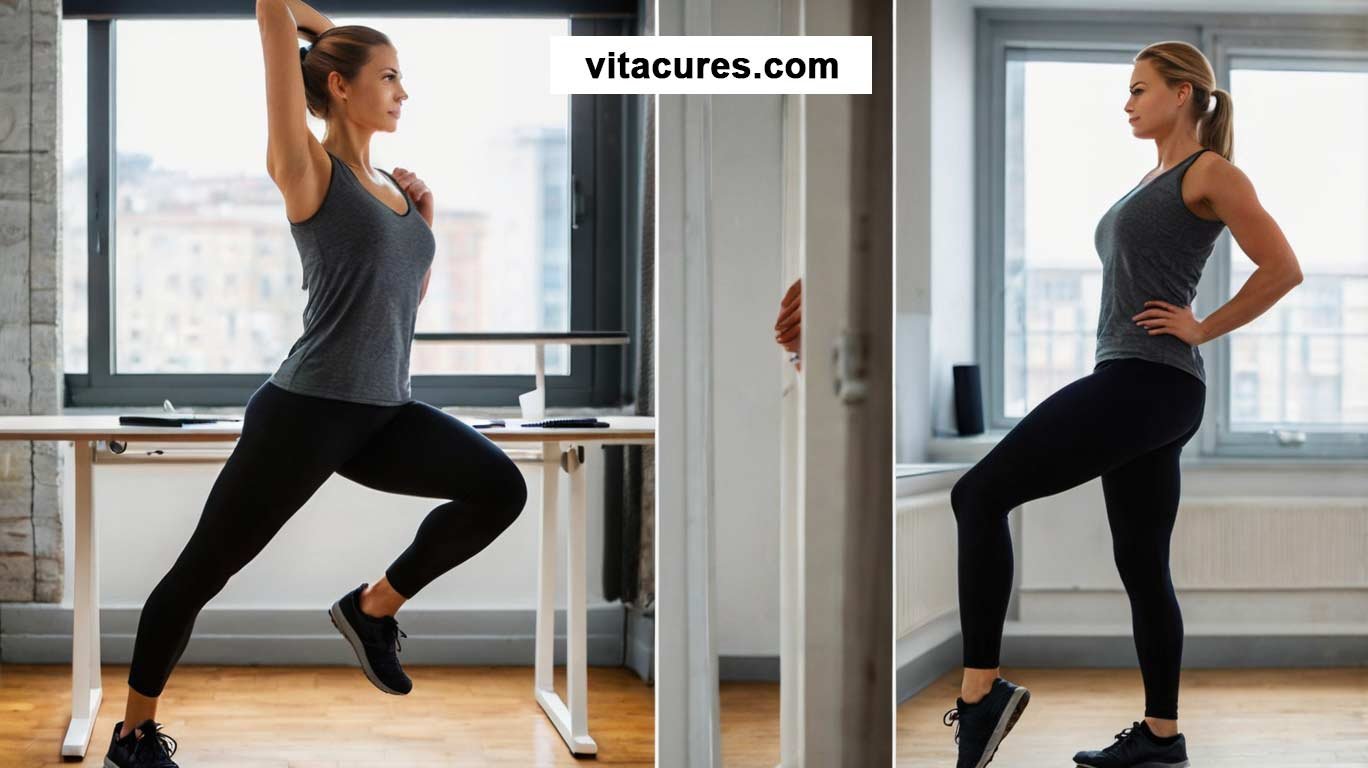
Here is a thorough list of 30 office exercises broken down by type that you can try right now. Each exercise includes instructions, benefits, and tips for effective execution.
1. Neck Stretches
Instructions:
- Sit or stand up straight.
- Slowly tilt your head towards your shoulder until you feel a stretch on the opposite side.
- Hold for 15-30 seconds and switch sides.
Benefits:
- Reduces tension in the neck.
- Improves flexibility and range of motion.
Tips:
- Perform this exercise 2-3 times a day, especially after long periods of computer use.
2. Shoulder Rolls
Instructions:
- Sit or stand up straight.
- Lift your shoulders towards your ears, roll them back, and then drop them down.
- Repeat for 10-15 rolls, then switch directions.
Benefits:
- Relieves shoulder tension.
- Improves circulation in the upper body.
Tips:
- Incorporate shoulder rolls during phone calls or meetings.
3. Wrist and fingerstretches
Instructions:
- Extend one arm forward, palm up.
- Use your other hand to gently pull back on your fingers.
- Hold for 15 seconds, then switch sides.
Benefits:
- Alleviates strain from typing.
- Increases flexibility in the wrists and fingers.
Tips:
- Perform this exercise hourly to combat stiffness.
4. Upper Back Stretch
Instructions:
- Sit up straight and extend your arms in front of you.
- Interlace your fingers and push your palms away from your body.
- Hold for 15-30 seconds.
Benefits:
- Stretches the upper back and shoulders.
- Improves posture.
Tips:
- Do this stretch during breaks to counteract slouching.
5. Cat-Cow Stretch
Instructions:
- Sit at the edge of your chair.
- Arch your back (cat position) and tuck your chin to your chest.
- Then, lift your chest and arch your back (cow position).
- Alternate between the two positions for 5-10 repetitions.
Benefits:
- Improves spinal flexibility.
- It relieves tension in the back.
Tips:
- Perform this stretch at the start and end of your workday.
6. Torso Twist
Instructions:
- Sit up straight and place your right hand on the back of your chair.
- Twist your torso to the right, holding for 15-30 seconds.
- Switch sides.
Benefits:
- Enhances spinal mobility.
- It relieves tension in the back and hips.
Tips:
- Use this stretch after sitting for long periods.
7. Seated Leg Extensions
Instructions:
- Sit in your chair with your feet flat on the floor.
- Extend one leg out straight and hold for a few seconds.
- Lower it back down and switch legs. Repeat for 10-15 reps.
Benefits:
- Strengthens the quadriceps.
- Improves circulation in the legs.
Tips:
- Perform this exercise while on calls or during meetings.
8. Desk Push-Ups
Instructions:
- Stand a few feet away from your desk.
- Place your hands on the desk and step back.
- Lower your body towards the desk, then push back up.
- Repeat for 10-15 reps.
Benefits:
- Strengthens the chest, arms, and shoulders.
- Increases heart rate.
Tips:
- Use a sturdy desk for stability.
9. Chair Squats
Instructions:
- Stand in front of your chair with feet shoulder-width apart.
- Lower yourself as if you are going to sit, but stop just above the chair.
- Hold for a moment, then rise back up. Repeat for 10-15 reps.
Benefits:
- Strengthens legs and glutes.
- Improves balance and coordination.
Tips:
- Focus on keeping your knees behind your toes.
10. Wall Sits
Instructions:
- Stand against a wall and slide down until your knees are at a 90-degree angle.
- Hold this position for 15-30 seconds.
Benefits:
- Strengthens the legs and core.
- Improves endurance.
Tips:
- Keep your back flat against the wall.
11. Calf Raises
Instructions:
- Stand up and rise onto your toes, then lower back down.
- Repeat for 10-15 reps.
Benefits:
- Strengthens the calves.
- Improves balance.
Tips:
- Perform this exercise while waiting for the printer or during breaks.
12. Seated Side Bends
Instructions:
- Sit up straight and raise one arm overhead.
- Lean to the opposite side, holding for 15-30 seconds.
- Switch sides.
Benefits:
- Stretches the sides of the body.
- Relieves tension in the lower back.
Tips:
- Take deep breaths while holding the stretch.
13. Hip Flexor Stretch
Instructions:
- Stand up and take a step back with one foot, bending your front knee.
- Keep your back leg straight and push your hips forward.
- Hold for 15-30 seconds and switch sides.
Benefits:
- Stretches the hip flexors, which can get tight from sitting.
- Improves flexibility.
Tips:
- Perform this stretch after long periods of sitting.
14. Ankle Circles
Instructions:
- While sitting, lift one foot off the ground and rotate your ankle in a circular motion.
- Do this for 10-15 circles in each direction, then switch feet.
Benefits:
- Improves ankle mobility.
- Reduces stiffness in the lower legs.
Tips:
- Incorporate this exercise during quiet times at your desk.
15. Glute Squeeze
Instructions:
- While sitting, squeeze your glute muscles and hold for 5 seconds.
- Release and repeat for 10-15 reps.
Benefits:
- Strengthens the glutes.
- Improves posture.
Tips:
- Do this exercise discreetly during meetings.
16. Standing Side Leg Lifts
Instructions:
- Stand up straight and hold onto your desk for balance.
- Lift one leg out to the side, keeping it straight.
- Lower it back down and repeat for 10-15 reps, then switch legs.
Benefits:
- Strengthens the hip abductors.
- Improves balance.
Tips:
- Keep your upper body straight while lifting your leg.
17. Seated Torso Stretch
Instructions:
- Sit up straight and interlace your fingers behind your head.
- Gently pull your elbows back and lift your chest.
- Hold for 15-30 seconds.
Benefits:
- Opens up the chest and shoulders.
- Relieves upper back tension.
Tips:
- Breathe deeply while holding the stretch.
18. Walking Meetings
Instructions:
- Instead of sitting in a conference room, hold meetings while walking.
- Encourage participants to walk with you around the office or outdoors.
Benefits:
- Increases physical activity.
- Enhances creativity and focus.
Tips:
- Choose a safe, quiet area for walking meetings.
19. Seated Foot Taps
Instructions:
- While sitting, tap your feet up and down quickly for 30 seconds.
- Rest for a moment and repeat for 3 sets.
Benefits:
- Increases circulation in the legs.
- Provides a quick energy boost.
Tips:
- Combine this with other seated exercises for a mini workout.
20. Standing Forward Bend
Instructions:
- Stand up straight with your feet hip-width apart.
- Bend forward at the hips, reaching towards the floor.
- Hold for 15-30 seconds.
Benefits:
- Stretches the hamstrings and lower back.
- It relieves tension from sitting.
Tips:
- Bend your knees slightly if you feel tightness in your hamstrings.
21. Standing Chest Stretch
Instructions:
- Stand and interlace your fingers behind your back.
- Straighten your arms and lift your chest.
- Hold for 15-30 seconds.
Benefits:
- Opens the chest and shoulders.
- Counteracts the effects of hunching over a desk.
Tips:
- Perform this stretch frequently if you have a desk job.
22. Seated Marching
Instructions:
- While sitting, lift your knees alternately as if marching.
- Do this for 30 seconds to 1 minute.
Benefits:
- Improves lower body strength and circulation.
- Provides a quick energy boost.
Tips:
- Engage your core while marching to enhance stability.
23. Lateral Arm Raises
Instructions:
- Stand up straight and raise your arms to the sides until they are parallel to the floor.
- Lower them back down. Repeat for 10-15 reps.
Benefits:
- Strengthens shoulder muscles.
- Improves upper body strength.
Tips:
- Use light weights or water bottles for added resistance.
24. Standing Calf Stretch
Instructions:
- Stand facing a wall with your hands against it.
- Step back with one foot, keeping it straight and pressing the heel into the ground.
- Hold for 15-30 seconds and switch sides.
Benefits:
- Stretches the calves.
- Reduces tightness in the legs.
Tips:
- Use this stretch after standing for long periods.
25. Desk Plank
Instructions:
- Place your hands on the desk and walk your feet back until your body forms a straight line.
- Hold for 15-30 seconds.
Benefits:
- Strengthens the core, shoulders, and arms.
- Improves overall body stability.
Tips:
- Keep your body aligned and avoid sagging your hips.
26. Deep Breathing
Instructions:
- Sit comfortably and take a deep breath in through your nose, allowing your abdomen to expand.
- Exhale slowly through your mouth. Repeat for 5-10 breaths.
Benefits:
- Reduces stress and anxiety.
- Increases oxygen flow to the brain.
Tips:
- Incorporate this exercise during stressful moments.
27. Side lungs
Instructions:
- Stand with feet hip-width apart.
- Step to the side with one foot, bending that knee while keeping the other leg straight.
- Push back to the starting position and switch sides. Repeat for 10-15 reps.
Benefits:
- Strengthens inner and outer thighs.
- Improves balance and flexibility.
Tips:
- Keep your chest lifted and back straight during the lunge.
28. Seated Hip Stretch
Instructions:
- Sit on the edge of your chair and cross one ankle over the opposite knee.
- Lean forward gently to feel a stretch in the hip.
- Hold for 15-30 seconds and switch sides.
Benefits:
- Stretches the hip muscles and glutes.
- It relieves tightness from sitting.
Tips:
- Perform this stretch whenever you need a quick break.
29. Plank Shoulder Taps
Instructions:
- Get into a plank position with your hands on the desk.
- Tap your left shoulder with your right hand and vice versa.
- Repeat for 10-15 taps.
Benefits:
- Strengthens the core and shoulders.
- Improves stability and coordination.
Tips:
- Keep your body straight and avoid rotating your hips.
30. Hydration Break
Instructions:
- Take a moment to stand up and drink a glass of water.
- While drinking, perform gentle neck stretches or shoulder rolls.
Benefits:
- Keeps you hydrated.
- Provides a brief movement break.
Tips:
- Keep a water bottle at your desk as a reminder to hydrate.
Incorporating these 30 office exercises into your daily routine can significantly improve your physical and mental well-being. Aim to integrate a few exercises throughout your workday to combat the negative effects of prolonged sitting. Whether during meetings, phone calls, or breaks, these simple movements can enhance your overall health, productivity, and comfort at work.
How can office exercises improve productivity?
- Increased Energy Levels:
- Engaging in physical activity, even for a short period, can boost energy levels. This is primarily due to increased blood flow and oxygen delivery to the brain, enhancing mental alertness and reducing feelings of fatigue.
- Enhanced focus and concentration:
- Exercise has been shown to improve cognitive function, allowing for better focus and concentration. A quick break for physical activity can clear your mind, helping you return to your tasks with a refreshed perspective.
- Improved Mood:
- Physical activity releases endorphins, the body’s natural mood elevators. A better mood can lead to improved collaboration with coworkers and a more positive attitude toward work tasks.
- Reduced Absenteeism:
- Regular exercise can improve overall health, reducing the likelihood of illnesses and, consequently, absenteeism. Healthier employees are more present and engaged in their work.
- Better Time Management:
- Incorporating short exercise breaks encourages employees to prioritize their time effectively. By scheduling these breaks, employees often find they can work more efficiently, ultimately improving productivity.
- Enhanced Creativity:
- Physical movement can stimulate creative thinking. Stepping away from your desk for a few minutes to stretch or walk can inspire new ideas and solutions.
What Quick Exercises Can I Do During Breaks?
- Desk Push-Ups:
- Stand a few feet away from your desk, place your hands on the edge, and perform push-ups. This engages your upper body and core.
- Chair Squats:
- Stand in front of your chair, lower yourself as if sitting down, but don’t fully sit. Hold for a moment before standing back up. This strengthens your legs and glutes.
- Neck Rolls:
- Roll your head in a circular motion to relieve tension in your neck. Perform for 30 seconds in each direction.
- Wrist Stretches:
- Extend one arm in front, palm up, and gently pull back on your fingers with the other hand to stretch your wrist and forearm.
- Calf Raises:
- Stand and lift your heels off the ground, balancing on your toes. Lower back down and repeat. This strengthens your calves and improves balance.
- Marching in Place:
- Simply march in place for 1-2 minutes to get your heart rate up. This is easy to do at your desk and requires no extra space.
- Wall Sits:
- Lean against a wall with your feet shoulder-width apart and slide down until your knees are at a 90-degree angle. Hold this position for as long as you can.
- Seated Leg Extensions:
- While sitting, extend one leg out straight, hold for a few seconds, and lower. Alternate legs for 10-15 reps.
- Deep Breathing Exercises:
- Take a moment to close your eyes, inhale deeply through your nose, and exhale slowly through your mouth. Repeat for 5 breaths to calm your mind.
- Side Stretches:
- Stand or sit and reach one arm overhead, leaning to the opposite side to stretch your side muscles. Hold for 15-30 seconds on each side.
Why Should I Incorporate Office Exercises into My Routine?
- Combat Sedentary Lifestyle:
- Many office jobs involve long periods of sitting. Incorporating exercise can help counteract the health risks associated with a sedentary lifestyle, including obesity and cardiovascular diseases.
- Boost Physical Health:
- Regular movement helps improve cardiovascular health, muscle strength, flexibility, and overall physical fitness. This can lead to a longer, healthier life.
- Enhance Mental Well-being:
- Physical activity is linked to lower rates of anxiety and depression. Incorporating exercise into your workday can provide a mental break and reduce stress.
- Create a Healthy Workplace Culture:
- Encouraging a culture of health and wellness at work fosters team bonding and collaboration. When everyone is encouraged to stay active, it can lead to a more supportive work environment.
- Increase Overall Productivity:
- As mentioned earlier, exercise boosts energy levels, focus, and creativity, directly impacting productivity and work performance.
- Improve Posture and Reduce Pain:
- Regular stretching and strengthening exercises can improve posture and reduce musculoskeletal pain, leading to increased comfort while working.
How Do Office Exercises Help with Stress Relief?
- Physical Release:
- Exercise is a natural way to release built-up tension in the body. Movements like stretching or walking can help ease tightness in muscles, reducing physical stress.
- Endorphin Release:
- Engaging in physical activity stimulates the release of endorphins, neurotransmitters that act as natural painkillers and mood elevators, promoting feelings of happiness and relaxation.
- Mindfulness and Focus:
- Many office exercises encourage mindfulness, which can help clear your mind of stressors. Focusing on your movements can shift your attention away from work-related pressures.
- Social Interaction:
- Group exercises or walking breaks with coworkers can foster a sense of community and support, which is beneficial for mental health and stress management.
- Improved Sleep:
- Regular physical activity can improve sleep quality, which is crucial for effective stress management. Better sleep leads to increased resilience against stressors.
- Break from Routine:
- Taking time for exercise provides a break from the daily grind, allowing for mental refreshment. This can help you return to your tasks with renewed focus and energy.
Conclusion
Incorporating office exercises into your daily routine is a simple yet effective way to improve productivity, reduce stress, and enhance overall well-being. By taking short breaks for physical activity, you can create a healthier, more vibrant work environment while benefiting your mental and physical health. Whether through quick stretches, strengthening exercises, or mindful movements, the key is to prioritize your health amidst a busy workday.

What Are the Best Exercises for Beginners?
For beginners, it’s essential to start with simple, low-impact exercises that build a strong foundation. Effective options include walking, bodyweight squats, push-ups, and planks. These exercises improve overall fitness, strength, and flexibility without overwhelming the body. Additionally, activities like cycling and swimming are excellent for building cardiovascular endurance. Aim for a mix of strength training and aerobic exercises to create a well-rounded fitness routine.
How Often Should You Exercise for Optimal Health?
To achieve optimal health, aim for at least 150 minutes of moderate-intensity aerobic activity weekly, spread across several days. This could be 30 minutes of brisk walking on five days. Additionally, include strength training exercises for all major muscle groups on two or more days per week. Consistency is key, as regular exercise helps maintain overall health, improve fitness levels, and reduce the risk of chronic diseases.
What Are the Benefits of Regular Exercise?
Regular exercise offers numerous benefits for both physical and mental health. It helps control weight, strengthens muscles and bones, and boosts cardiovascular fitness. Additionally, exercise enhances mood and reduces anxiety and depression symptoms by releasing endorphins. It also improves sleep quality and increases energy levels. Long-term, regular physical activity can lower the risk of chronic diseases such as heart disease, diabetes, and certain cancers, promoting overall well-being.
How Do Different Exercises Target Specific Muscle Groups?
Different exercises focus on specific muscle groups to build strength and endurance. For instance, squats primarily target the quadriceps, hamstrings, and glutes, while push-ups engage the chest, shoulders, and triceps. Core exercises like planks work the abdominal muscles and lower back. Incorporating a variety of exercises into your routine ensures balanced muscle development and prevents overuse injuries. This targeted approach helps in achieving fitness goals more effectively.
What Equipment Do You Need for Home Workouts?
For effective home workouts, consider investing in basic equipment that enhances your routine. Essential items include resistance bands for strength training, dumbbells for added weight, and a yoga mat for floor exercises and stretching. A stability ball can improve core strength, while a jump rope is great for cardio. Optional equipment like kettlebells or a pull-up bar can diversify your workouts. Ensure you have enough space to move safely.
How to Create a Balanced Exercise Routine?
To create a balanced exercise routine, incorporate various types of workouts targeting cardiovascular health, strength, flexibility, and balance. A good plan might include aerobic exercises like walking or cycling for 150 minutes weekly, along with two days of strength training focusing on major muscle groups. Don’t forget to include flexibility exercises, such as stretching or yoga, to improve mobility. Regularly adjust your routine to prevent plateaus and maintain engagement.
How to Stay Motivated to Exercise Regularly?
Staying motivated to exercise regularly can be challenging but achievable. Set realistic, achievable goals and track your progress to maintain accountability. Find a workout buddy to keep you accountable and make exercising more enjoyable. Additionally, mix up your routine to prevent boredom and explore new activities or classes. Reward yourself for reaching milestones and remind yourself of the physical and mental benefits of regular exercise.
How to Properly Warm Up Before Exercising?
A proper warm-up is crucial for preparing your body for exercise and preventing injuries. Start with 5-10 minutes of light aerobic activity, such as brisk walking or gentle cycling, to increase your heart rate. Follow this with dynamic stretches, focusing on the muscle groups you’ll be using during your workout. This combination improves blood flow, enhances flexibility, and primes your muscles for more intense physical activity, ensuring an effective workout.
How to Choose the Right Exercise for Your Goals
Selecting the right exercise for your goals requires understanding what you want to achieve. For weight loss, prioritize aerobic activities like running or cycling. If building strength is your goal, focus on resistance training with weights or bodyweight exercises. Flexibility and balance can be improved with yoga or Pilates. Consider your interests and lifestyle to choose activities you enjoy, as this increases adherence and overall satisfaction with your fitness journey.
How to Track Your Progress in Fitness Effectively?
Tracking your fitness progress is essential for motivation and goal achievement. Use a fitness journal or mobile app to log workouts, noting exercises, repetitions, and duration. Regularly assess your performance through measurements like weight, body measurements, or fitness tests. Setting specific milestones and tracking them visually can provide motivation. Remember to celebrate your achievements, as this reinforces positive behavior and keeps you focused on your fitness journey.
Top 10 Exercises for a Full-Body Workout
- Squats: Engages multiple muscle groups, including quads, hamstrings, and glutes. It builds strength and stability.
- Push-ups target the chest, shoulders, and triceps. This classic exercise improves upper body strength and core stability.
- Deadlifts: Works the back, glutes, and hamstrings. This compound movement enhances overall strength and posture.
- Plank: Engages the core, shoulders, and back. It improves stability and strengthens the entire midsection.
- Lunges: Targets the legs and glutes while enhancing balance and coordination. They can be done forward, backward, or side-to-side.
- Burpees: A full-body exercise combining squats, push-ups, and jumps. They boost cardiovascular fitness and strength.
- Mountain Climbers: Great for building cardiovascular endurance while engaging the core and legs. They can be performed at a high intensity.
- Kettlebell Swings: Strengthens the legs, back, and shoulders. This dynamic movement also increases heart rate for cardiovascular benefits.
- Jumping Jacks: A simple aerobic exercise that boosts heart rate and engages the entire body, perfect for warming up.
- Rowing (Machine or Bodyweight): Engages multiple muscle groups, including the back, arms, and legs. It’s great for building strength and endurance.
5 Quick Exercises to Boost Your Energy
- Jumping Jacks: Perform 30 seconds of jumping jacks to elevate your heart rate and stimulate blood circulation.
- High Knees: Stand in place and bring your knees up to your chest for 30 seconds. This exercise boosts cardiovascular fitness and energizes the body.
- Wall Sits: Lean against a wall with knees bent at a 90-degree angle for 30 seconds. This builds lower body strength and endurance.
- Seated Torso Twists: While seated, twist your torso side to side for 30 seconds. This helps improve circulation and energizes the core.
- Deep Breathing: Take a minute to perform deep breathing exercises. Inhale deeply through your nose and exhale slowly through your mouth, which helps increase oxygen flow and clarity.
Best Exercises for Strengthening Your Core
- Plank: Maintain a straight line from head to heels, holding for as long as possible to engage all core muscles.
- Russian Twists: Sit on the floor, lean back slightly, and rotate your torso side to side while holding a weight or ball to target the obliques.
- Bicycle Crunches: Lie on your back, bringing opposite elbows to knees while pedaling your legs. This exercise works the entire core.
- Leg Raises: Lie on your back and lift your legs to a 90-degree angle. This effectively targets the lower abdominal muscles.
- Mountain Climbers: In a plank position, alternate bringing knees to your chest quickly to engage the core while providing a cardiovascular workout.
- Birddog: From a tabletop position, extend one arm and the opposite leg. This stabilizing exercise strengthens the core and improves balance.
- Dead Bug: Lie on your back with arms and legs up, then lower opposite limbs while keeping your back flat. This targets the entire core effectively.
- Side Plank: Lie on your side and lift your body off the ground, supporting it with one arm. This focuses on the obliques.
- Stability Ball Rollouts: Kneel and roll a stability ball forward while engaging the core. This enhances balance and core strength.
- Toe Touches: Lie on your back with legs raised, and reach for your toes with your hands. This engages the upper abs effectively.
Fun Exercises to Try at Home This Weekend
- Dance Party: Turn up your favorite music and dance around your living room. It’s a great way to get moving and have fun!
- Yoga Flow: Follow a beginner-friendly online yoga class for relaxation and flexibility. It can help reduce stress and improve posture.
- Bodyweight Circuit: Create a circuit of bodyweight exercises like squats, push-ups, and burpees. Set a timer for 20 seconds of work followed by 10 seconds of rest.
- Hula Hooping: Grab a hula hoop for a fun cardio workout that engages your core while improving coordination.
- Jump Rope: If you have a jump rope, it’s a fantastic cardiovascular workout that can be done indoors or outdoors.
Essential Exercises for Beginners to Get Started
- Walking is a simple and effective low-impact exercise. Aim for 20-30 minutes daily to improve cardiovascular health.
- Bodyweight Squats: Focus on proper form to strengthen the legs and glutes. Start with 10-15 repetitions.
- Wall Push-Ups: Begin with push-ups against a wall before progressing to the floor. This builds upper body strength safely.
- Seated Leg Raises: While sitting, raise one leg at a time to strengthen the quadriceps. Perform 10-15 reps for each leg.
- Gentle Stretching: Incorporate full-body stretches to improve flexibility and prevent injury. Focus on major muscle groups, holding each stretch for 15-20 seconds.
- Chair Yoga: Follow simple chair yoga routines to improve flexibility and relaxation while being seated.
- Lunges: Start with stationary lunges, focusing on form before adding movement. Aim for 5-10 reps on each leg.
- Glute Bridges: Lie on your back, knees bent, and lift your hips to strengthen the glutes and lower back.
- Cat-Cow Stretch: A gentle way to improve spinal flexibility and mobility. Alternate between arching and rounding your back.
- Plank Holds: Start with short holds, focusing on maintaining proper form to strengthen the core.

